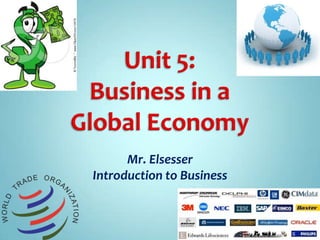
Unit 5 - Global Business Notes
- 1. Mr. Elsesser Introduction to Business
- 2. This unit will allow us to explore: Why the world has become a global economy. Why people and countries specialize in producing goods and services. The concept of “free trade.” Who benefits and who does not benefit from free trade.
- 3. Answer this question… “What does the term GLOBAL ECONOMY mean to you?”
- 4. A Global Economy is: The interconnected economies of the nations of the world. Fueled by TRADE: Specific area of business or industry, skilled occupation, or the people who work in a specific area of business or industry International Trade: The exchange of goods and services between nations.
- 5. Economies that are developed are GLOBALIZED by… Multinational Corporations: a company that does business in many countries and has facilities and offices around the world Can you identify a multinational corporations?
- 7. Domestic Trade: The production, purchase, and sale of goods/services within home country. World Trade: The exchange of goods and services across international boundaries. Imports: Goods and services that one country buys from another country Exports: Goods and services that one country sells to another country
- 8. Balance of Trade: The difference in value between a country’s imports and exports over a period of time. Trade Surplus: A country exports more than it imports. Trade Deficit: A country imports more than it exports. Is it better to have a surplus or deficit?
- 9. Trade Specialization: Countries that focus on particular activities, areas or product. Builds and sustains a market economy. Comparative Advantage: The ability of a country/company to produce a particular good more effectively than another. Top 10 Countries with a U.S. Trade Deficit Top 10 Countries with a U.S. Trade Surplus
- 10. Businesses must convert their money into that nation’s currency ($). Exchange Rate: The price at which one currency can buy another currency. Changes daily. Countries follow rates to find best prices for products.
- 11. 1. What is the global economy? 1. The interconnected economies of the nations of the world. 2. What is the difference between domestic trade and international trade? 1. Domestic trade is between parties within a country and international trade is between parties in different countries. 3. Why would a country want its currency its appreciate? 1. So citizens can buy more goods and services in other countries.
- 12. Why might a country impose limits or restrictions on its own trading polices?
- 13. Competition often leads to disputes, therefore trade policies may differ among countries. Protectionism: The practice of government putting limits on foreign trade to protect businesses at home. Examples: Tariffs, quotas, embargos
- 14. Tariff: A trade barrier where tax is placed on imports to increase price in domestic markets. Quota: A trade barrier where limits are placed on quantities of products that can be imported. Examples of U.S. Tariff/Quota Commodities Embargo: A political or military trade barrier that bans the importing/exporting of products. Example: U.S. can not import Cuban products, cannot export military products.
- 15. Foreign competition can lower demand for products made at home. Protect home companies from unfair competition. Protect products related to national defense. Foreign cheap labor can lower wages/threaten jobs. Countries can become too dependent on others for important products. Other countries may not have the same environmental or human rights standards.
- 16. Some countries think no trade restrictions should exist throughout our globalized economy. Free Trade: Few or no limits on trade between countries. Led to the establishment of trade alliances North American Free Trade Agreement (NAFTA) European Union (EU) Association of Southeast Asian Nations (ASEAN)
- 17. Opens new markets in other countries. Creates new jobs. Competition forces business to be more productive/efficient. Consumers have more choices in products. Promotes cultural understanding/cooperation among countries. Helps countries raise their standard of living.
- 18. 1. Give 3 reasons for protectionism. 1. Protects businesses from unfair competition, from countries that violate U.S. human rights or environmental standards, and from overdependence on another country’s products. 2. Give 3 reasons for free trade. 1. encourages competition, gives consumers more choices for products, promotes cultural understanding 3. Define some of the world’s major trade alliances. 1. NAFTA, the EU and ASEAN